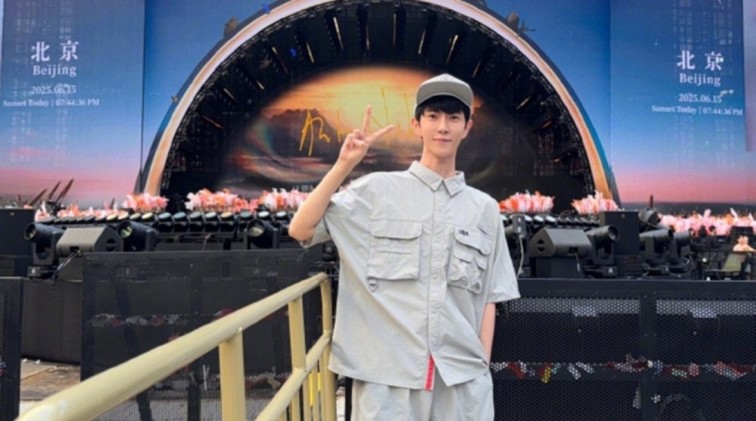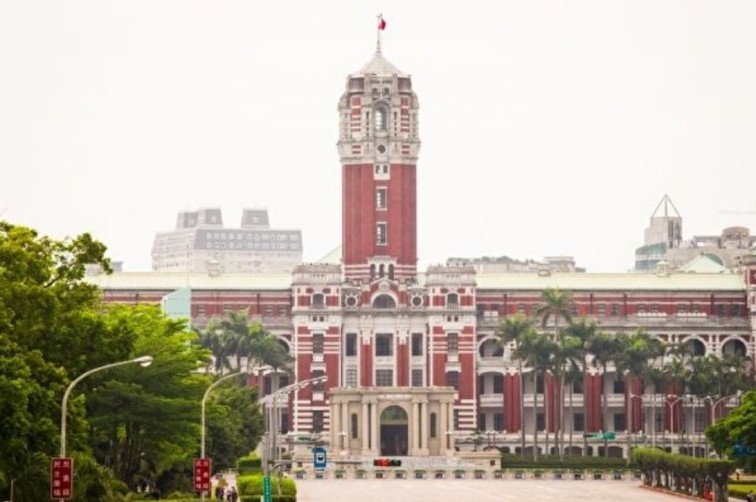Dark clouds hang over Tiananmen Square in Beijing. (Lintao Zhang/Getty Images)
[People News] As of October 2025, China is trapped in a vortex of multiple crises: economic growth has plunged to its lowest point, the real estate market is on the brink of a “death spiral,” waves of social unrest are simmering beneath the surface, and internationally, the U.S.–China trade war has re-escalated under Donald Trump’s second term, adding fuel to already tense global geopolitics.
According to ancient Chinese prophetic traditions known as “chènwěi” (omens and divination), the so-called “Red Horse and Red Sheep Catastrophe” (赤马红羊劫)—a period of chaos recurring every Bǐngwǔ (Fire Horse) and Dīngwèi (Fire Sheep) year—is said to bring great national upheaval. The 12th-century Song scholar Chai Wang, in his Bǐng-Dīng Guījiàn (《丙丁龜鑑》), recorded 21 such historical calamities, from the fall of the Zhou state to the collapse of the Later Han, all marked by the death of rulers or the downfall of dynasties.
Today, China’s supreme leader Xi Jinping, born in 1953 (the Year of the Water Snake), will be 73 years old during this fiery cycle. Prophecy followers claim that in this period—2026-2027, the “Fire Years”—he will meet his fated end: whether through sudden illness, political assassination, or death amid warfare, triggering a power vacuum and a nationwide collapse.
Origins and Symbolism of the “Red Horse and Red Sheep Catastrophe”
The term derives from the ancient sexagenary calendar’s Five-Element cosmology: The heavenly stems Bǐng (丙) and Dīng (丁) belong to fire, symbolising blazing upheaval. The earthly branches Wǔ (午, Horse) and Wèi (未, Sheep) denote restlessness and rebellion, representing popular uprisings and regime collapse. In Bǐng-Dīng Guījiàn, Chai Wang documented that from 255 BC (King Zhaoxiang of Qin) to AD 947 (Later Han of the Five Dynasties), all 21 Bǐng-Wǔ and Dīng-Wèi years were accompanied by catastrophic wars or imperial deaths. In more recent times: 1907 (Dīng-Wèi) — The Qing dynasty tottered; Emperor Guangxu and Empress Dowager Cixi both died, paving the way for the 1911 Xinhai Revolution. 1966 (Bǐng-Wǔ) — The Cultural Revolution erupted, plunging China into turmoil; Mao prolonged his own rule at the cost of national devastation.
These prophecies are seen not as superstition but as a metaphor for historical cycles: in years dominated by fire, accumulated tensions ignite. According to the 2025 Global Geopolitical Risk Report, the coming period will be defined by intensified U.S.–China confrontation, the protracted Russia–Ukraine war, and escalating cyber conflict. Economic decoupling and protectionism will worsen. In Trump’s second term, the U.S. has extended tariff truces until November 2025 but accelerated economic separation; China’s exports to the U.S. have plunged 15.5% in the first eight months of the year. These external shocks, as Chai Wang wrote, are “the turning of Heaven’s wheel,” paving the path toward the catastrophic cycle of 2026-2027.
Historical Mirrors: The Fall of Rulers and Power Vacuums
In all 21 cases recorded by Chai Wang, the supreme ruler could not escape fate. Below are selected examples of the “Bǐng-Dīng catastrophes” that coincided with the collapse of dynasties or deaths of emperors:
-
255 BC (Bǐng-Wǔ) – Eastern Zhou: The Zhou dynasty falls; King Zhaoxiang of Qin relocates the Nine Tripods, signaling the end of feudal order.
-
195 BC (Bǐng-Wǔ) – Western Han: Emperor Liu Bang dies; Empress Lü seizes power, causing the “Rebellion of the Lü Clan.”
-
AD 226 (Bǐng-Wǔ) – Cao Wei (Three Kingdoms): Emperor Cao Pi dies; Sima Yi rises, laying the groundwork for Wei’s fall to the Jin.
-
AD 1126 (Bǐng-Wǔ) – Northern Song: The Jin invade Kaifeng; Emperors Huizong and Qinzong are captured—“The Humiliation of Jingkang.”
-
AD 1127 (Dīng-Wèi) – The Northern Song collapses; imperial family taken north, leaving the Southern Song a fractured remnant.
-
AD 1167 (Dīng-Wèi) – Emperor Gaozong dies; internal instability shakes the Southern Song.
-
AD 1907 (Dīng-Wèi) – Qing dynasty: The simultaneous deaths of Guangxu and Cixi leave the empire on the brink; the dynasty falls four years later.
-
AD 1966 (Bǐng-Wǔ) – People’s Republic of China: The Cultural Revolution begins; Mao extends his personal rule but brings the nation to the edge of collapse.
These cases are not coincidences but manifestations of the ancient doctrine of “Heaven-Human Resonance”: in years of fiery energy, Heaven burns away the old order, while the horse and sheep portend rebellion among the people.
In modern times, Mao Zedong’s 1966 Cultural Revolution may have postponed his personal reckoning, yet it plunged China into chaos. Mao himself died a decade later, in 1976 (Bǐng-Chén)—another fire-related year. Now, as 2026-2027, the next “Red Horse and Red Sheep” cycle approaches, many see it as the greatest trial for the CCP since its founding. Folk seers and prophetic texts such as Liu Bowen’s Tui Bei Tu speak of an imminent “great change in China,” with predictions of nuclear conflict, social upheaval, and regime collapse looming on the horizon.
Xi Jinping’s “Fated Catastrophe”: A Perfect Storm of Global and Domestic Crises
Xi Jinping’s personal fate, according to Chinese metaphysics, is tied to the Water Snake of his birth year (1953). When encountering Fire years—specifically the Bǐng-Wǔ (Fire Horse, 2026) and Dīng-Wèi (Fire Sheep, 2027)—his water element meets fire, “like oil poured on flames.” In 2026, at age 73, he enters what fortune-tellers describe as his “bad luck turning point,” the threshold of “the Gate of Ghosts.” In recent years, Xi’s grand military parades—such as the 2025 Beijing Military Review—were interpreted by believers as attempts to “ward off disaster.” Yet, people recall that soon after the 2019 parade, the COVID-19 pandemic broke out. His political clampdowns—purging the Party, tightening control over Taiwan—have only hastened the coming crisis: in 2025, the internal Party purge and the “Red Sheep Catastrophe” (a period of fiery turmoil) are said to converge.
A Global Powder Keg. The 2025 geopolitical environment has been described as an era of “multi-crisis instability.” The U.S.–China trade war has no winners. Trump’s second-term policies have intensified tech sanctions and Taiwan tensions. Global risk reports note that U.S.–China competition is reshaping supply chains, while climate stress fuels geopolitical friction, and national security now outweighs economic efficiency. China’s exports to the U.S. have fallen 15.5%, compounded by the Russia–Ukraine war and an energy shortage that has placed foreign reserves under pressure. In this narrative, the Russia–Ukraine war becomes the international mirror of the “Red Horse and Red Sheep” calamity: In 2026, Ukraine, backed by NATO and led by the U.S., fully recovers all territories seized by Russia. Former Russian president Vladimir Putin, fearing postwar retribution, commits suicide in the Kremlin by poisoning himself. However, documents he leaves behind explode like a bombshell: secret CCP-Russia aid agreements, personal letters between Xi and Putin, and evidence of their collusion in the invasion of Ukraine. When these fall into NATO’s hands, Western outrage peaks. NATO decides on a 2027 spring military response—not a full-scale war, but targeted strikes and decapitation operations against China’s leadership. When this intelligence reaches Beijing, Xi Jinping reportedly becomes consumed by fear. The Party descends into chaos; anti-Xi sentiment erupts across the nation. Protests and denunciations surge online and offline, and the global press covers the regime’s turmoil as China sinks into total diplomatic isolation.
A Society Ready to Ignite. Domestically, conditions are equally combustible. Protest incidents are surging: In Handan, Hebei, homebuyers besieged local government offices. Widespread wage arrears triggered labour riots. Unprecedented acts of dissent followed: a man projected anti-regime messages before the 2025 parade; local officials were attacked in August; mass demonstrations ensued. Police data show 19 “revenge attacks” recorded in late 2024—but triple that number in 2025. As public protest databases are shut down, it’s clear that “severe social conflict” is escalating. Citizens condemn lenient treatment of abusers and ineffective “reeducation” policies, warning of societal breakdown. Youth unemployment soars, corruption spreads, and millions of families fall into poverty. The ancient seer Liu Bowen’s Tui Bei Tu prophecy is repeatedly cited online—foretelling “great upheaval in China”, nuclear war, social chaos, and regime collapse.
In 2026 (Fire Horse), stock market crashes, tsunamis, or nuclear risks are predicted as preludes. In 2027 (Fire Sheep), it is widely believed that Xi will either die suddenly or the country will fracture under warlordism. Netizens lament darkly: “Within half a year, our sons will be sent to the front, and mothers will die waiting—China’s sacrifice to nuclear fire.” Trusted allies such as Wang Huning are said to crumble; Taiwan begins stockpiling food in anticipation of mainland unrest. History’s pattern repeats: in years of catastrophe, rulers die and regimes fall in a chain reaction. The prophecy’s climax points to February 1, 2027 — Xi Jinping’s death, allegedly from poison administered by a Liu clan uprising and a woman surnamed Cai. This “green tea poison” symbolises both an ultimate betrayal within the Party and the inevitable backlash after exposure of the CCP–Russia conspiracy. Putin’s documents, like sparks from the Kremlin, ignite a chain collapse that consumes Zhongnanhai itself.
Modern Interpretation: From Fate to Warning
Though the “Red Horse and Red Sheep Calamity” (Chì Mǎ Hóng Yáng Jié) comes from ancient prophecy, it mirrors the turmoil of today: in 2025, China’s economy grows only 4–5%, falling short of the official 5% target. Xi Jinping’s so-called “technological-industrial vision” can no longer conceal the deep pains of economic transformation. His death, whether by illness, assassination, or in war, will mark a historic turning point, opening the door to a new era. Across the nation and abroad, voices praying for his downfall and for the collapse of the Chinese Communist Party are rising.
“Heaven’s justice never fails; who has ever escaped its cycle?” As the Fire Horse (2026) and Fire Sheep (2027) years gallop into being, Xi Jinping’s “Chinese Dream” is destined to end in tragedy. In this calamity, nothing is certain— for even an emperor is only mortal. The convergence of global storms and China’s internal crisis makes this not merely Xi’s personal catastrophe, but the catastrophe of an entire era.
(Source: X New Heights) △











News magazine bootstrap themes!
I like this themes, fast loading and look profesional
Thank you Carlos!
You're welcome!
Please support me with give positive rating!
Yes Sure!